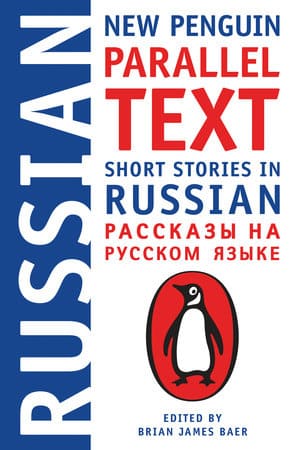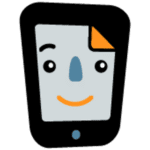
7 Places to Find Parallel Text Books Online
Let’s say you’ve traveled to a place where you can’t read the signs in the local language.
Thankfully, the signs are also in English, so you can still understand everything.
Wouldn’t it be great if you could also work with longer texts like articles, stories and whole books like this?
In this post, we’re going to look at some great places for parallel text books and how you can use them to teach yourself a language.
Contents
- A New Way to Read? Features and Benefits of Parallel Text Books
- 7 Online Resources for the Best Parallel Text Books
- How to Use Parallel Text Books
- And One More Thing...
Download: This blog post is available as a convenient and portable PDF that you can take anywhere. Click here to get a copy. (Download)
A New Way to Read? Features and Benefits of Parallel Text Books
First, let’s look at exactly what parallel texts for learners look like.
Parallel text books often place one language meant to be familiar to the reader (like English) on one page and the target language on the other side. This is often what’s meant when “parallel texts” are mentioned. Another, less common type of parallel or dual text comes in the form of “interlinear” books, which show a translation of the line you’re reading directly underneath it.
Both of these types of texts allow you to get a sense of big-picture comprehension without translating in your head.
There are multiple ways that people use parallel texts to learn languages. Really, all of them are helpful, and each person just has to come up with their own technique, but we’ll discuss some specific ideas below to get you started.
Using these techniques can help you learn the language faster and retain it more by developing mental connections with what you’re reading.
The most common way to use these texts is to only use your native language when it’s absolutely necessary for understanding what’s going on in the text. This keeps you from just leaning on a language you already know.
By only consulting the “teaching language” when absolutely necessary, you get the experience of extensive reading without the pain of having to do it in the normal way. This also means that all the input you’re getting is comprehensible, which helps grow your vocabulary, grammar and other subtle aspects of the language.
In the end, the goal of the parallel text books is to help you understand and learn at the same time by helping you when you need it and not helping you when you don’t need it.
They’re incredibly powerful tools that can teach you a very nuanced version of the language you’re trying to learn.
7 Online Resources for the Best Parallel Text Books
Here’s a list of online resources to help you find the parallel books you can use to jumpstart your learning and enjoy yourself at the same time.
Penguin Parallel Texts
Penguin Parallel Texts are a fantastic resource—especially for your first parallel text book project. They offer quite a wide variety of languages, so they’ll probably be a good option even if you’re not learning one of the more common languages like Spanish or French.
These books contain a wealth of short stories that you can read, which is great for people who are new readers in their target language. A full book all at once can be way too much, but a few short stories each day gives you time to rest and take breaks.
If you’re new to reading in your target language, you should consider using Penguin Parallel Texts to boost your abilities.
Polyglot Planet Publishing
Polyglot Planet Publishing offers a methodical system that you can use to find something to read at whatever level you find yourself. By progressing through the difficulty levels of their short-story based texts, you’ll be building up core vocabulary and terminology.
Another interesting and useful aspect of these books is that you can find some of them in specific categories, like business Spanish.
Reading in the particular category that you’re interested in can help you because you’ll learn more relevant information, which means you’ll learn faster and stay more engaged.
Another great thing about these books is that some of them are available in audiobook format. Using the audiobook in conjunction with your normal reading can help you get a feel for pronunciation, rhythm and accent.
Whether you’re new to reading in your target language or have done it for a while, these books will be able to provide you with a great platform for improvement.
Interlinear Books
As we mentioned, interlinear books are a very different take on parallel texts, but they’re still very beneficial. Rather than showing the two languages on two different pages, they show both on the same page with the teaching language right below the original. This style of text can help you get a feel for the nuances of your target language.
Interlinear Books offers this learning method for books that are considered classic literature, which brings in a ton of cultural value. These books are some of the most famous books written in each language, so you get to learn about things that have shaped a culture, be entertained and learn a lot of information at the same time—not to mention the fact that you’ll simply be reading some of the best-known books ever written.
It’s also very easy to access these books because you download them right to your computer or tablet, which makes them accessible at any point throughout the day and great for a commute.
Easy Readers
Easy Readers is another great source of parallel text e-books. These books are separated out by level, and by the specific CEFR levels, so it’s very easy to find the perfect book for your current level.
Almost all of these books come with audio, which just adds another layer of depth to your learning and allows you to retain the information better while working on your pronunciation.
If you’ve never tried it, you should definitely read a book at the same time that the audiobook is playing and try to mimic the exact sounds that the speaker makes. Easy Readers are a great way to get practice using this method.
Another great thing about Easy Readers is that they occasionally run awesome sales where some of their books are completely free. It’s definitely worth it to grab one!
Lonweb
Lonweb is an incredibly thorough database of language resources and is built around the idea that anybody can learn a language by themselves if they just have the right tools—and they’re giving you the right tools!
Once you get to the website, you’re greeted by literally hundreds of links to parallel texts in English and any of 55 other languages.
The variety of content on offer means books will be formatted differently and structured differently, so you have the chance to really find something that works well for you.
This is an excellent source for learners of all levels—just be prepared to do some digging. Hop on there and give it a try!
Parallel Books
Currently available for iOS devices, Parallel Books is an app that allows you to read books in other languages and reveal the text in your own language when you’re ready to use it. This is an excellent system because it gives the reader flexibility and customization while using a parallel book.
Because these are e-books, you can access many of them from the same platform and—the best part—they’re currently all free!
It’s hard to beat free and extensive language learning resources like what you have available on Parallel Books.
This app is perfect for your commute in the mornings, because it’s portable and you can have as many books as you want at any given time.
While it may seem obvious, don’t overlook Google as a great resource for parallel texts. The sites and resources that I mentioned here aren’t the only places to get parallel text books. All you have to do to find others is to do a simple Google search for parallel texts in whatever language you’re studying.
If you want to get even fancier, you can customize your search with keywords applying to level, type of work or length. You could even search specific titles. What you’re looking for might not be available—but maybe it is!
How to Use Parallel Text Books
To make the most of using parallel text books, follow these steps.
1. Don’t read both languages all the time.
This is the most important step on this list. Don’t read both languages every time you read—your native language is just an aid for understanding the target language and should be treated as such.
If you start reading both languages all the time, you’re basically giving your brain the green light to always translate in your head.
This is very important not to do because translating in your head is tiresome and only slows you down and keeps you from sounding natural when you speak.
2. Read often.
Reading in a new language is just like learning to read again. You need to be reading as much as possible so you can grow as much as possible. Take in as many different types of books as you can and read them until you can digest and retain the information in them.
Not only is reading often important to get used to the method of reading parallel texts, but it also just gets you comfortable around your new language and helps you begin to think in that language when you’re using it.
Essentially, the more you read, the better you’ll speak, read and write in the language that you’re studying.
3. Read out loud whenever possible.
This will probably make you uncomfortable at first, because most of us don’t regularly read out loud.
However, it’s very important to read books out loud when you’re reading in a foreign language because it solidifies the information and grammar and helps you with things like pronunciation, rhythm, tone, etc.
4. Don’t just read.
While reading is definitely one of the best ways to pump up your language skills, you can’t let other skills, like listening, go neglected.
Try to find the audiobook so you can listen to native speakers while working on your reading.
Combining listening and reading this way helps you make associations between sound and text that improve your overall language skills. It’s the same way you’d learn from captioned content on the streaming platform Netflix or subtitled media clips on the video-based learning program FluentU.
FluentU takes authentic videos—like music videos, movie trailers, news and inspiring talks—and turns them into personalized language learning lessons.
You can try FluentU for free for 2 weeks. Check out the website or download the iOS app or Android app.
P.S. Click here to take advantage of our current sale! (Expires at the end of this month.)
5. Read interesting books.
If you do a quick Google search for books in your target language, probably what comes up are some textbooks to learn the language and some graded readers.
While graded readers and children’s books are a great way to learn the basics of a language, good, full-length parallel text books with interesting stories are a far better way of practicing, getting better at real speech and learning the ins and outs of the language like a native.
Hopefully, I’ve at least convinced you that reading is a great way to learn about language and culture while enjoying yourself.
One of the best ways to incorporate reading into your daily routine until you get to a level where you can read well by yourself is with parallel texts. They preserve all the fun of reading books, but they give you a little support when you need it.
Today, we have access to more parallel texts than ever, so we might as well use it.
My challenge to you is to stop reading this article, go find one parallel text book and read at least one chapter. I think you’ll find that you enjoy the process and that it’s a beneficial one.
Good luck!
Download: This blog post is available as a convenient and portable PDF that you can take anywhere. Click here to get a copy. (Download)
And One More Thing...
If you dig the idea of learning on your own time from the comfort of your smart device with real-life authentic language content, you'll love using FluentU.
With FluentU, you'll learn real languages—as they're spoken by native speakers. FluentU has a wide variety of videos as you can see here:
FluentU has interactive captions that let you tap on any word to see an image, definition, audio and useful examples. Now native language content is within reach with interactive transcripts.
Didn't catch something? Go back and listen again. Missed a word? Hover your mouse over the subtitles to instantly view definitions.
You can learn all the vocabulary in any video with FluentU's "learn mode." Swipe left or right to see more examples for the word you’re learning.
And FluentU always keeps track of vocabulary that you’re learning. It gives you extra practice with difficult words—and reminds you when it’s time to review what you’ve learned. You get a truly personalized experience.
Start using the FluentU website on your computer or tablet or, better yet, download the FluentU app from the iTunes or Google Play store. Click here to take advantage of our current sale! (Expires at the end of this month.)












